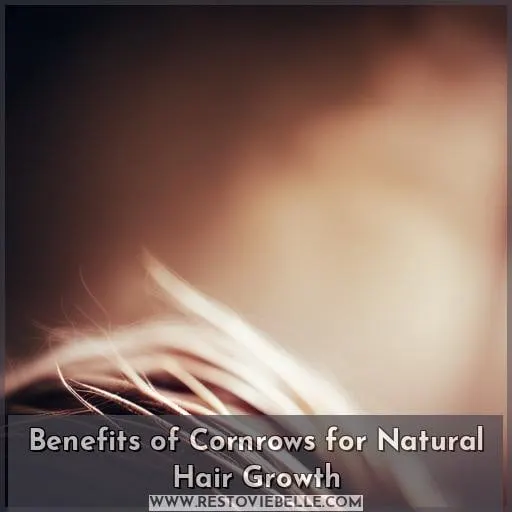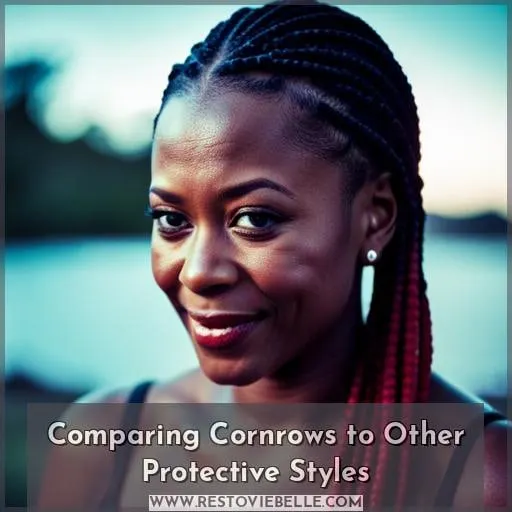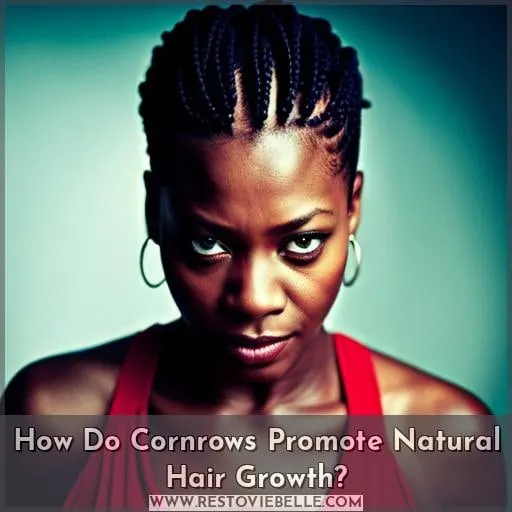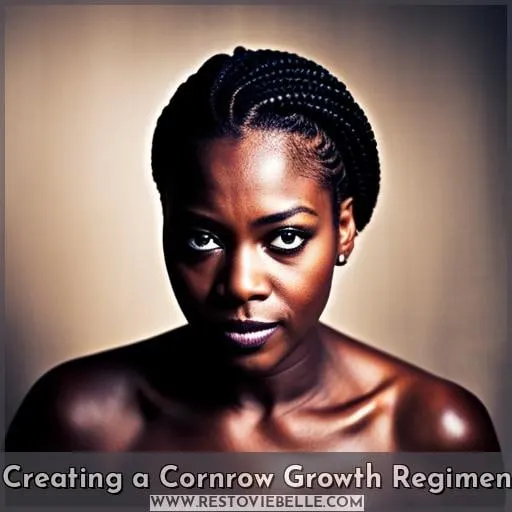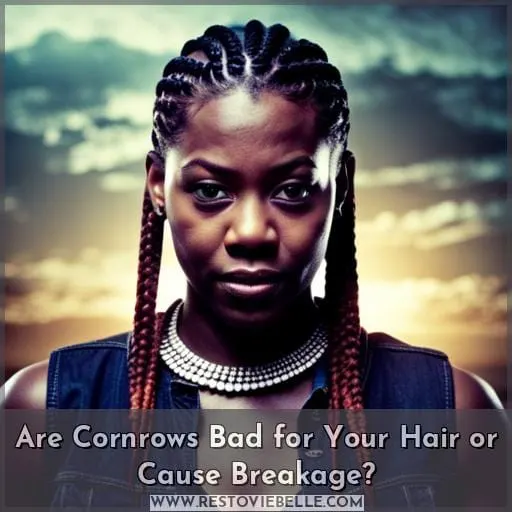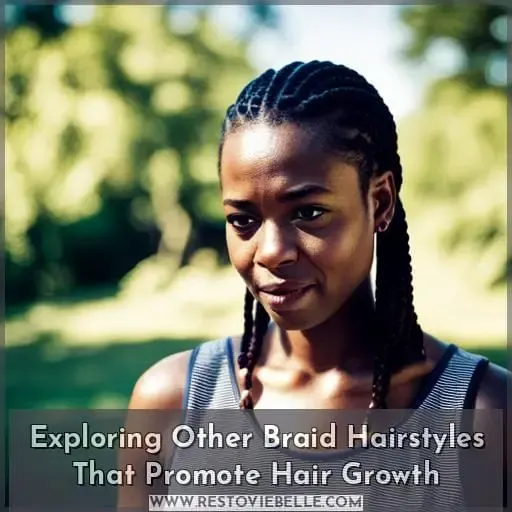This site is supported by our readers. We may earn a commission, at no cost to you, if you purchase through links.
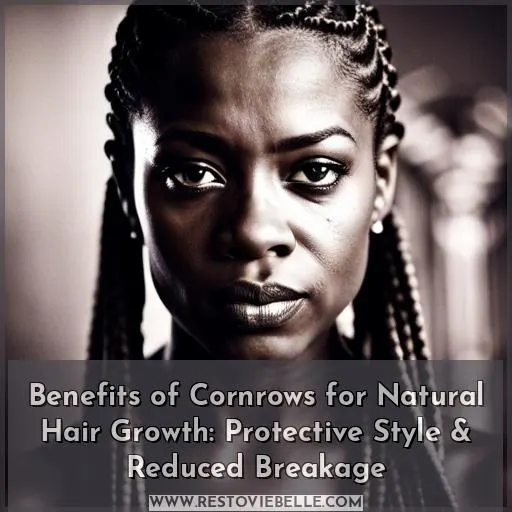 Ready to unlock the secrets to natural hair growth? Discover the benefits of cornrows for your luscious locks.
Ready to unlock the secrets to natural hair growth? Discover the benefits of cornrows for your luscious locks.
These protective hairstyles not only reduce breakage but also minimize manipulation and stress on your strands. With proper maintenance practices, you can achieve healthy and thriving hair growth like never before.
Find out how cornrows compare to other protective styles and learn why they’re a go-to choice for promoting strong, beautiful hair.
Get ready to rock those braids with confidence!
Table Of Contents
- Key Takeaways
- Benefits of Cornrows for Natural Hair Growth
- Comparing Cornrows to Other Protective Styles
- How Do Cornrows Promote Natural Hair Growth?
- Creating a Cornrow Growth Regimen
- Are Cornrows Bad for Your Hair or Cause Breakage?
- Exploring Other Braid Hairstyles That Promote Hair Growth
- Frequently Asked Questions (FAQs)
- What are some tips for caring for cornrows between wash days?
- How long should I wait between taking out cornrows and getting them redone?
- Do I need to use hair extensions for cornrows or can I do them on my natural hair?
- Can I exercise or swim while wearing cornrows?
- Is there anything I should avoid while my hair is in cornrows (e.g. hats, scarves)?
- Conclusion
Key Takeaways
- Reduce manipulation and breakage
- Minimize tension and stress on hair
- Protect hair from sun damage
- Promote overall hair health
Benefits of Cornrows for Natural Hair Growth
Cornrows are a protective hairstyle that can benefit natural hair growth in several ways.
As a protective style, cornrows reduce manipulation and breakage, allowing the hair to retain length and strength.
Additionally, cornrows minimize tension and stress on the hair strands, promoting healthier growth.
By incorporating proper maintenance practices such as moisturizing regularly and avoiding excessive pulling or tugging on the braids, you can maximize the benefits of cornrows for natural hair growth.
Protective Hairstyle
Cornrows are a protective hairstyle that not only reduces breakage but also promotes natural hair growth by safeguarding your strands.
They minimize tangling, protect the scalp, and prevent over-manipulation of the hair.
Cornrows reduce tension on the hair and provide a versatile style option for various occasions.
This protective style is favored by many individuals seeking to maintain healthy hair while still looking stylish.
Reduction of Manipulation and Breakage
By opting for cornrows as a protective hairstyle, you can significantly reduce manipulation and breakage of your natural hair.
The tight braiding pattern minimizes tangling and over-handling, allowing hair to grow undisrupted.
Cornrows form a protective barrier, shielding strands from damage while permitting access to nourishing elements.
This also helps prevent traction alopecia, a condition caused by excessive tension on hair follicles.
Overall, cornrows promote healthy hair growth by reducing key factors that can impede length retention.
Minimization of Tension and Stress on Hair
You can significantly minimize tension and stress on your hair by wearing cornrows, promoting natural hair growth.
Cornrows reduce tangling, minimize pulling, and prevent breakage.
By distributing the weight of the hair across multiple braids, cornrows alleviate strain on individual strands. This helps to protect against traction alopecia and promotes healthy hair growth.
Additionally, cornrows provide a protective style that keeps the ends of your hair tucked away and minimizes manipulation that can lead to breakage or damage.
Maintenance Practices for Healthy Hair Growth
To maintain healthy hair growth while wearing cornrows, it’s important to implement proper maintenance practices.
Here are four essential tips for maintaining your cornrows and promoting natural hair growth:
- Wrap your braids every night with a satin or silk scarf to protect them from friction and breakage.
- Clean your hair before getting it braided to promote a clean, healthy scalp conducive to hair growth.
- Moisturize your braids consistently with a suitable leave-in conditioner or braid spray.
- Minimize tension on the hair by avoiding tight hairstyles and using gentle styling techniques.
Comparing Cornrows to Other Protective Styles
When considering protective styles for natural hair growth, it’s important to compare cornrows with other options available.
Cornrows offer several advantages that make them stand out among other protective styles.
One key benefit of cornrows is the reduced tension they provide compared to some alternative hairstyles like box braids or dreadlocks. This lower level of tension minimizes stress on the hair strands and scalp, promoting healthier growth and reducing the risk of breakage.
Additionally, cornrows are versatile in terms of styling options while still maintaining a sleek and stylish appearance. They’re also low-maintenance, allowing for easy management without compromising on style or hair health.
Overall, cornrows offer a protective yet manageable hairstyle that encourages natural hair retention and promotes overall healthy growth.
How Do Cornrows Promote Natural Hair Growth?
When it comes to promoting natural hair growth, cornrows offer several benefits that contribute to healthier and stronger hair.
- Cornrows protect hair from sun damage: By tightly braiding the strands close to the scalp, cornrows create a barrier against harmful UV rays, minimizing sun damage and preventing dryness.
- Cornrows reduce tangling: The structure of cornrow braids minimizes friction between individual strands, reducing tangles and knots that can lead to breakage.
Creating a Cornrow Growth Regimen
To create a cornrow growth regimen, it’s important to start by prepping your hair using organic hair care products.
When braiding, ensure that you use proper techniques and avoid making the braids too tight to prevent damage.
Additionally, maintaining moisturization and hydration through regular application of leave-in conditioners or braid sprays is crucial for healthy hair growth.
Lastly, proper removal and maintenance practices such as not wetting or brushing the braids excessively are essential for preserving the integrity of your natural hair after removing the cornrows.
Prepping the Hair
Start by prepping your hair for cornrows to create a growth regimen that promotes healthy and thriving natural hair.
Begin by dividing your hair into three sections, ensuring equal distribution of the braids.
Start braiding at the small section of the hairline, using an underhand motion for continuous raised rows.
As you become more comfortable with cornrows, you can upgrade to other patterns or add extensions for length if desired.
Braiding Techniques
To create a cornrow growth regimen that promotes natural hair growth, you’ll need to master the proper braiding techniques.
The tightness of your cornrows is essential for protecting your hair and reducing the risk of traction alopecia. Professional stylists can provide guidance on achieving the right balance between tightness and comfort.
Additionally, consider incorporating protective styling methods like adding extensions for extra length or experimenting with different patterns to maintain interest in your style while promoting healthy hair growth.
Moisturization and Hydration
To maintain healthy hair growth while wearing cornrows, it’s essential to consistently moisturize and hydrate your braids.
Moisturizing your braids helps reduce dryness, prevent split ends, promote a healthy scalp, prevent damage, and improve elasticity.
By regularly applying moisturizers or leave-in conditioners to your cornrows, you can ensure that your hair stays hydrated throughout the duration of the style. This won’t only keep your hair looking shiny and vibrant but also support its overall health and growth.
Proper Removal and Maintenance
When removing and maintaining your cornrows for optimal natural hair growth, it’s important to follow a proper regimen.
To preserve the integrity of your braids, wrap them every night using satin or silk materials to avoid breakage caused by cotton pillows.
Consistently moisturize your braids to prevent dryness and promote healthy hair growth.
Additionally, make sure to clean your hair before getting it braided to create a clean and healthy scalp environment conducive for long-term hair health.
Are Cornrows Bad for Your Hair or Cause Breakage?
Now that you understand how to create a cornrow growth regimen for your natural hair, let’s address the question on many people’s minds: Are cornrows bad for your hair or do they cause breakage? The answer is quite the opposite.
Cornrows are actually a protective style that can help promote healthy hair growth.
Contrary to popular belief, cornrows don’t cause breakage when done correctly and with proper maintenance. In fact, they protect your strands by reducing manipulation and tension on the hair. By braiding tightly near the scalp, cornrows prevent tangling and minimize over-handling of your locks during styling.
This allows for uninterrupted periods of growth while maintaining length and strength in 4C hair types specifically.
So rest assured knowing that rocking those stylish cornrows won’t harm but rather benefit your precious tresses!
Exploring Other Braid Hairstyles That Promote Hair Growth
You’ll find that other popular braided styles like box braids, fishtail braids, and rope twists also help protect hair and encourage growth by minimizing manipulation.
- Box braids reduce daily styling and pulling on hair follicles.
- Twists keep hair contained, preventing breakage from friction.
- Bantu knots shield ends from exposure to harsh elements.
- Crochet braids cut back on chemical relaxers while allowing a stylish look.
These options relieve hair stress, enabling natural hair to flourish in its healthiest state. Trying varying braided hairstyles allows you to determine which best nurtures your hair goals for length and strength over time.
Frequently Asked Questions (FAQs)
What are some tips for caring for cornrows between wash days?
Wrap your cornrows in a scarf at night.
Use a braid spray daily to moisturize.
Avoid getting them wet or brushing between wash days, as this can cause tangling.
Be gentle when touching up edges or adjusting the style.
After 4-6 weeks, remove the braids to avoid breakage.
How long should I wait between taking out cornrows and getting them redone?
Give your scalp and hair a break before rebraiding.
Allow at least 2 weeks for your hair and scalp to recover from the tension of the previous cornrows. This gives follicles a chance to strengthen, minimizing potential breakage when braided again.
Do I need to use hair extensions for cornrows or can I do them on my natural hair?
You can absolutely do cornrows on your natural hair without extensions.
As long as your hair is at least a few inches long, cornrows make an excellent protective style to nurture growth of healthy, natural locks.
Can I exercise or swim while wearing cornrows?
Yes, you can exercise and swim while wearing cornrows.
However, it’s important to protect your hair by wearing a swimming cap or tying your braids up to prevent tangling and damage from chlorine or saltwater.
Is there anything I should avoid while my hair is in cornrows (e.g. hats, scarves)?
While wearing cornrows, it’s advisable to avoid:
- Tight hats or scarves that can put pressure on the braids and cause breakage.
- Opt for loose-fitting headwear to protect your style without compromising hair health.
Conclusion
Ultimately, cornrows can be an ideal protective style for promoting healthy, natural hair growth. By reducing manipulation and tension while allowing moisture to access your strands, they minimize breakage.
For the best results, prep hair properly, maintain gentle braiding techniques, and keep cornrows moisturized.
Worn with care, these braids let you show off your beautiful locks as you grow them long and strong.
Now you can rock cornrows with confidence, knowing they safeguard your hair.

